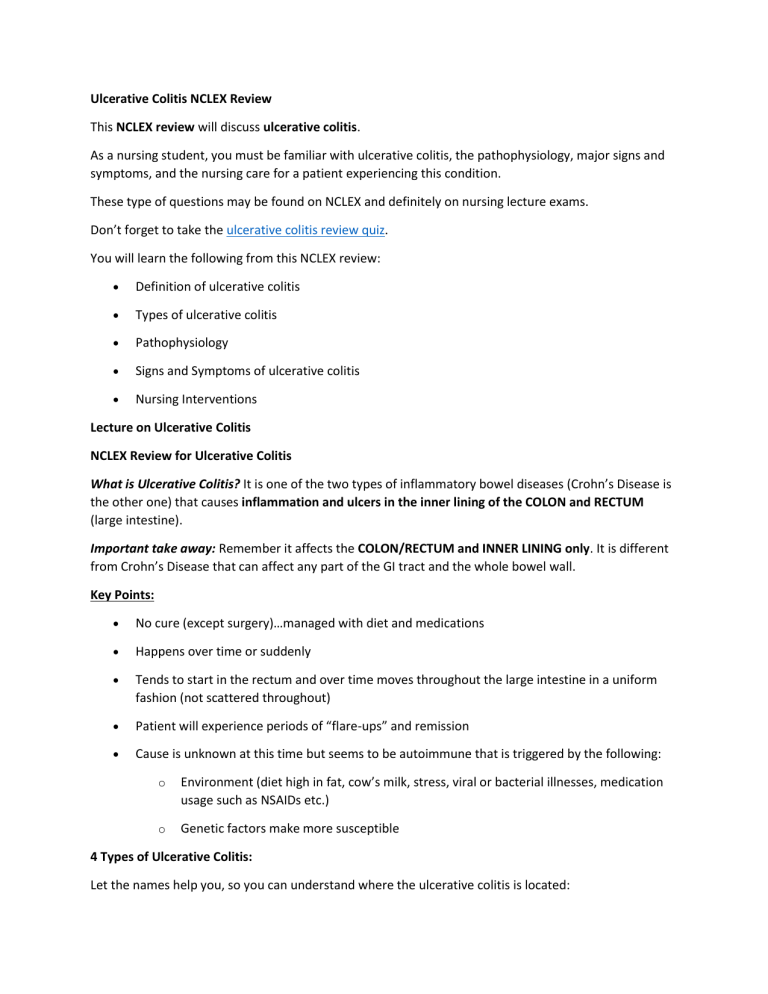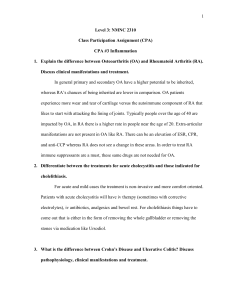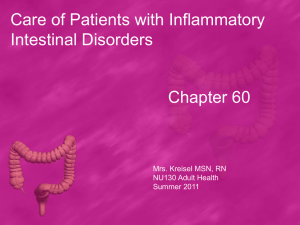
Ulcerative Colitis NCLEX Review This NCLEX review will discuss ulcerative colitis. As a nursing student, you must be familiar with ulcerative colitis, the pathophysiology, major signs and symptoms, and the nursing care for a patient experiencing this condition. These type of questions may be found on NCLEX and definitely on nursing lecture exams. Don’t forget to take the ulcerative colitis review quiz. You will learn the following from this NCLEX review: • Definition of ulcerative colitis • Types of ulcerative colitis • Pathophysiology • Signs and Symptoms of ulcerative colitis • Nursing Interventions Lecture on Ulcerative Colitis NCLEX Review for Ulcerative Colitis What is Ulcerative Colitis? It is one of the two types of inflammatory bowel diseases (Crohn’s Disease is the other one) that causes inflammation and ulcers in the inner lining of the COLON and RECTUM (large intestine). Important take away: Remember it affects the COLON/RECTUM and INNER LINING only. It is different from Crohn’s Disease that can affect any part of the GI tract and the whole bowel wall. Key Points: • No cure (except surgery)…managed with diet and medications • Happens over time or suddenly • Tends to start in the rectum and over time moves throughout the large intestine in a uniform fashion (not scattered throughout) • Patient will experience periods of “flare-ups” and remission • Cause is unknown at this time but seems to be autoimmune that is triggered by the following: o Environment (diet high in fat, cow’s milk, stress, viral or bacterial illnesses, medication usage such as NSAIDs etc.) o Genetic factors make more susceptible 4 Types of Ulcerative Colitis: Let the names help you, so you can understand where the ulcerative colitis is located: Ulcerative proctitis (PROCT: rectum and ITIS: inflammation….inflammation of the rectum): affects the rectum and is the most mild form of all types. It tends to have fewer complications due to being located just in the rectum. Proctosigmoiditis: PROCT: COLON and SIGMOID: SIGMOID COLON and ITIS: inflammation…inflammation of the rectum and sigmoid colon. Pancolitis (PAN: ALL COL: colon ITIS: inflammation…inflammation of the entire colon). It is a very severe form of ulcerative colitis. Left-sided colitis: LEFT-SIDED: includes the descending colon, sigmoid colon, and rectum and ITIS: inflammation….inflammation of the descending, sigmoid, and rectum. What is happening to the large intestine with Ulcerative Colitis? There is massive inflammation in the large intestine (it depends on how extensive based on the type of ulcerative colitis the patient has). The inflammation causes the cells of the lining to die which causes ulcers to form and they bleed and produce pus. Due to the massive amount of inflammation, the large intestine cannot function normally. Therefore, it can’t absorb water. Normally, when GI contents enter into the large intestine from the small intestine (at the cecum) the contents is watery. The large intestine will absorb that water as it travels through the different areas of the colon. The stool will then start to have a solid form. However, due to the inflammation with ulcerative colitis it can’t, so the patient has diarrhea. The diarrhea will be bloody (along with pus/mucous) because as the contents passes over the ulcers it will mix with the blood/pus/mucous. Furthermore, the patient will have frequent bowel movements (or intense urge to defecate) because of the inflammation causing the rectum to want to empty. Patients will have bouts of flare-ups and remission (where it comes and goes). The ulcerative sites will heal but the lining will be damaged. So, from the continuous cycle of healing and ulcer formation, polyps will form (called pseudopolyps) along with scar tissue which leads to bowel narrowing and shortening. Overtime, due to severe cases, the large intestine will start to lose its unique form. It won’t have those small pouches (haustra) present. The haustra help with food churning throughout the large intestine. Instead, the large intestine will start to appear smooth….like a lead pipe which is called the “lead pipe sign” and is seen on a barium enema. Severe cases of Ulcerative Colitis can lead to: • Rupture of the bowel: a hole or holes form in the bowel from repeated ulceration. This leads to peritonitis (leaking of intestinal contents into the abdominal cavity). • Toxic megacolon: the large intestine dilates due to the overwhelming inflammation…hence the name MEGA: large and colon and it becomes TOXIC. The large intestine is unable to function properly and becomes paralyzed…it eventually can rupture. o Typical signs and symptoms of toxic megacolon include: abdominal distention, fever, diarrhea, abdominal pain, dehydration, and tachycardia, hypoactive/absent bowel sounds Tests to Diagnose Ulcerative Colitis: • Colonoscopy: small camera used to examine the whole colon • Barium enema: x-ray used to assess the colon. An enema of contrast is given through the rectum to help line the colon and rectum for x-ray pictures. Then the anatomy of the colon can be assessed by the physician. Signs and Symptoms of Ulcerative Colitis Remember: “Ulcers” Urgent/frequent need to have bowel movements Loss of weight due to constant diarrhea, low red blood cells (anemia) Cramps in abdomen (very painful) Electrolyte imbalances, elevated temperature Rectal bleeding Severe diarrhea (pus, blood, mucous) Nursing Interventions for Ulcerative Colitis • Monitor VS, patient’s bowel movements (what does it look like and its frequency), keep patient hydrated, monitor daily weights (for weight loss), focus on GI assessment (bowel sounds: hyperactive, hypoactive, or absent, tenderness) • Signs and symptoms of toxic megacolon: abdominal distention, fever, diarrhea, abdominal pain, dehydration, tachycardia, hypoactive or absent bowel sounds • Signs and Symptoms of peritonitis: distention or abnormal bloating, increased heart rate, tachypnea, pain (note toxic megacolon can lead to peritonitis) • May be NPO with IV hydration…advance diet per MD order as symptoms subside…will typically start with clear, fulls, and then solids • Diet Education: o o Watch foods that can cause a “flare-up” or should be avoided during a “flare-up”: ▪ High-fiber foods (they require a lot of digestion and the gut needs to rest) ▪ Food hard to digest like: nuts, raw vegetables or fruits (cooked are better) ▪ Allergen type foods: dairy or certain foods that the person may be intolerant too like wheat, fish ▪ Avoid spicy, high-fat foods, gluten, gas causing foods like onions, beans etc. Foods to eat during “flare-up” or to prevent one: ▪ Low fiber (easier on the gut to digest), high-protein and stay hydrated • Importance about regular screening of colon cancer • If patient had surgery, educate about ostomy placement: know the nursing pre and post care, how to provide ostomy care (diet, how to change pouching system, stoma care etc.) Administering Medications per MD order: Goal: control flare-ups and maintain remission • Medications prescribed depend on the severity of the disease (most ulcerative colitis cases are controlled with diet and medications while other require surgery). • Combination of medications are used if patient has moderate to severe case. Anti-inflammatory: decrease the inflammation in the bowel • 5-Aminosalicylates (5-ASA): “Sulfasalazine” ….first line for mild to moderate…helps maintain remission..prevents flare-ups…if not responding MD may add on corticosteroids (can’t take if allergic to sulfa) • Steroids: “corticosteroids” Prednisone….used when Aminosalicylates aren’t working…not used long term but patient will be tapered off…nasty side effects high glucose, thinning skin, easy bruising, osteoporosis Immuno-suppressors/modulators: used when other medications haven’t work or patient needs to be off of steroids due to their side effects • They work by decreasing the response of the immune system and sometimes used in combination of steroids. Immunosuppressors: ” Azathioprine/Imuran “…risk for infection and cancer, no live vaccines (MMR, varicella, shingles etc.) Immunomodulators: “Adalimumab/Humira”: tumor necrosis factor blocker (anti-TNF): blocks a protein that plays a role in the inflammatory process….MD will check patient for TB before starting medication…can reactivate a previous infection or put patient at risk for a TB infection and increases risk of cancer….no live vaccines Antibiotics: treat or prevent infections during flare-ups “Ciprofloxacin” Antidiarrheal Meds: “Imodium use” sparing and watch for toxic megacolon risk Pain: NO NSAIDS can cause flare-up..use Tylenol type medications Surgery: Proctocolectomy: complete removal of the colon and rectum…patient will have a permanent ileostomy Ileoanal anastomosis (J-pouch): colon and rectum removed and a pouch is created that is attached to the ileum to allow stool to pass from the small intestine to the anus (so no outside ostomy created)




